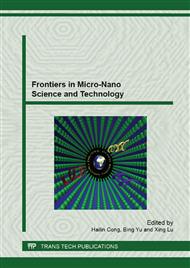p.212
p.217
p.227
p.233
p.253
p.260
p.269
p.275
p.281
Thermal and Flame Retardant Properties of MWNT Reinforced Conductive PAN Film
Abstract:
Conductive polyacrylonitrile film reinforced by multiwall carbon nanotubes was prepared via ultrasonic dispersion and vacuum casting. The structure of MWNT/PAN composite film was characterized by WAXD and FT-IR. The LOI of the blend was enhanced from 18.1 % to 24.5 % and TGA show better thermal stability. MWNT composite at 10 wt% MWNT loading showed an electrical conductivity of 10-2S/cm.
Info:
Periodical:
Pages:
253-259
Citation:
Online since:
April 2014
Authors:
Keywords:
Price:
Сopyright:
© 2014 Trans Tech Publications Ltd. All Rights Reserved
Share:
Citation:


